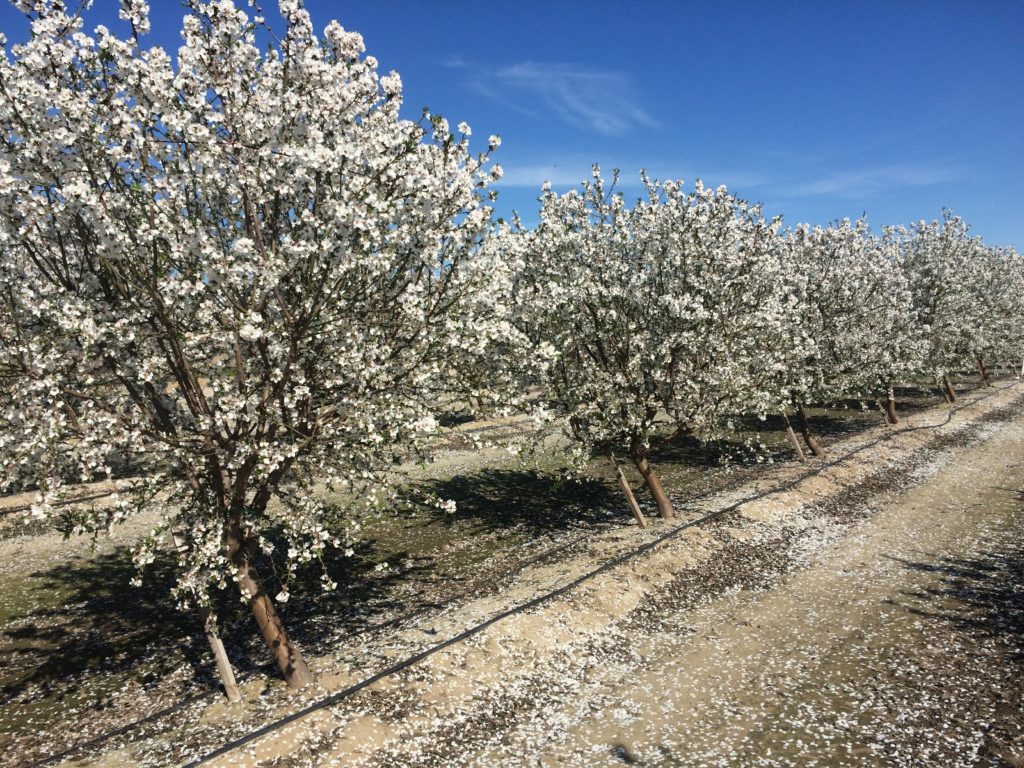Almond bloom is just around the corner. This “start” to the season is an important period for almond production as flowers require reasonable weather conditions for pollination, fertilization, and eventual fruit set to occur. With that in mind, below are a few considerations for this period.

Rain or conditions favoring dew can increase the amount of disease. Pathogens affecting almond flowers are ubiquitous in the environment, and therefore the condition that influences infection are periods of leaf wetness. Fungicides should be applied to protect the flowers from rain-splashed spores and subsequent infections. Newer class fungicides can move into the upper cell layers of the flower and kill infections, but this “reach-back” potential only provides about 2-3 days of “cure” after a rain event.
Start the spray program with fungicides that are most effective for blossom diseases, but provide limited protection for petal fall and spring-time diseases. This typically includes the FRAC groups 1 and 9. As bloom progresses into petal fall, other fungicides should be considered to manage anthracnose, green fruit rot, shot-hole, and scab. FRAC groups 3, 7, 11 or combinations of these products should be considered.
Remember to rotate away from fungicide FRAC groups used in previous sprays. This will help reduce the formation of resistance within pathogens, increasing the “shelf life” of a fungicide. To assist with this, especially if rainy conditions are expected, consider utilizing a broad spectrum material at petal fall or shortly after this period to provide the ability to use strobilurins and DMIs (FRAC 11 and 3) for scab and rust control. Some good rotational, broad spectrum products include chlorothalinil (FRAC M5), Ziram (M3) or Captan (M4).
Don’t forget about the bees. Honeybees are brought into the orchard to provide pollination services – a requirement for production for most California type almond varieties (even self-fertile varieties seem to benefit from bees!). Do not mix insecticides with bloom sprays, and check the label of the fungicide to determine if additional surfactants are needed.
Fungicide sprays ideally should occur at a time to reduce bee exposure. This is generally in the afternoon and into the night. Also, hive strength should be monitored to make sure the contracts are being fulfilled.
Keep track of temperature. Warm temperatures during bloom will accelerate progress, which may mean spray schedules may need to be changed. Cooler or mild temperatures have the opposite effect. Temperatures below freezing are concerning as it may kill flowers. As buds progress through the flowering stages, they become more sensitive to cold. Nights with temperatures below 28-29 degrees should utilize the irrigation system to increase orchard heat. Utilize in-field temperature sensors as orchards may be cooler than reported temperatures in the urban areas. Only frost protect when needed as too much water at this time can saturated the soils, impacting tree health. If unable to frost protect all the acres at night, consider providing soil moisture during the day or run every-other row to stretch the water.
For further asistance on bloom time considerations, remember to review the Fungicide Efficacy tables provided at the UC IPM website as well as “Growing the Valley” podcasts posted by Phoebe Gordon (UCCE Madera) and Luke Milliron (UCCE Butte).


Donny Hicks
February 6, 2019Hey David, hope all is well. Thanks for the update. Got pretty cold this morning, 28 for a short while. Buds are moving from green to pink. Looks like the forecast is a few degrees colder tonight. Hopefully fields will dry out so we can get a spray on.
David Doll
February 8, 2019Hey Donny!
Thanks for the update. Those colder temps should help slow development – as long as the trees are pink bud or earlier, they can handle pretty cold temperatures (~26F). Looks like more rain in the forecast, so i hope things can dry out enough to help ease operations.
Wish you the best- hope to see you in the future.
David
Daniel
February 11, 2019I have been given several conflicting advise as to adding boron in the spray at full Bloom. Some say no problem, some say don’t. Can you provide clarity as if this is ok not ok in relation to causing issue with bees and or pollen
thanks,
db
David Doll
February 18, 2019Daniel,
At the current understanding, boron wont affect bees or pollen. Boron helps direct pollen tube growth as it grows towards the increasing concentration of boron. Boron must be applied early enough that it can be moved into the ovary and increase the rate of fertilization. If applied to late, this effect is diminished. There is some thought – although never proven – that applying boron too late can decrease yield. This is based on misdirection of the pollen tube growth. From multiple research trials, the best results form boron come from applications made from postharvest to pink bud. Applying it at later bud stages provides inconsistent results (sometimes it improves yields, sometimes not). Hope that helps,
david
Seth
February 14, 2019What is the general opinion on adding foliar nutrients such as zinc and potassium along with the fungicide spray mix?
David Doll
February 18, 2019Seth,
Thanks for the comment. An article on this topic was written in previous years – please see here: https://thealmonddoctor.com/2011/01/27/bloom-spray-additives-do-they-work/. From my experience, bloom spray products outside of ones containing boron can be inconsistent. This probably has a lot to do with the inherent health and nutrient status of a given orchard.
David